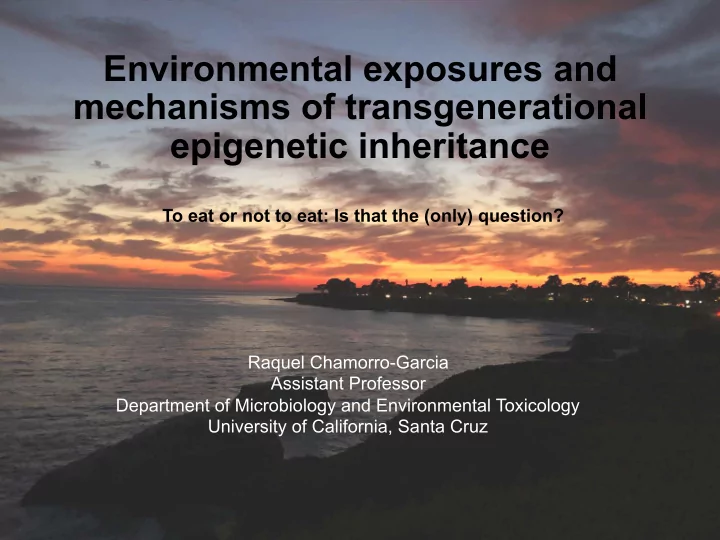

Environmental exposures and mechanisms of transgenerational epigenetic inheritance To eat or not to eat: Is that the (only) question? Raquel Chamorro-Garcia Assistant Professor Department of Microbiology and Environmental Toxicology University of California, Santa Cruz
Global impact of obesity Global Burden of Obesity Economy Social Health • Developing countries cannot • Cardiovascular disease • $2.0 trillion worldwide afford the costs • Diabetes • Direct costs • Stigma • Musculoskeletal disorders • Indirect costs • Cancer
Contributing factors to obesity Positive energy balance (calories in vs. calories out) Genetics Stress Gut microbiome Infections Smoking Malnutrition
Multigenerational studies in humans Dutch famine Lumey & Poppel, 2013 Preconception F2 offspring Health & in utero from F1 Outcomes in exposure to women offspring famine Obesity, lipid profile, metabolic syndrome Poor health Diabetes, glucose metabolism Fertility Cognition, psychiatric disorders Adult mortality
Multigenerational inheritance One One Genetics phenotype mutation Mendelian laws Dominant vs recessive phenotype Homozygous vs heterozygous vs WT Environmental perturbation Obesity Lipid profile Metabolic syndrome Diabetes Epigenetics ? Glucose metabolism Fertility Cognition Psychiatric disorders Adult mortality
Epigenetics Alterations that lead to a “stably heritable phenotype resulting from changes in a chromosome without alterations in the DNA sequence” - Cold Spring Harbor Conference, 2008 Conrad H. Waddington
Contributing factors to obesity Positive energy balance (calories in vs. calories out) Genetics Stress Gut microbiome Infections EDCs? Smoking Malnutrition
Exposure Metabolic of F0 F1 F2 F3 F4 disruption Pregnant F4 animals Females Final Initial Transgenerational epigenetic inheritance endpoint alteration ? Modes of action Which parental line? Epigenetic Target tissues Epigenetic marks in germline Characterization DNA methylation Mechanisms of propagation? Histone modifications Tributyltin Noncoding RNAs Epigenetic reprogramming? Phthalates Methoxychlor EDCs Glyphosate Dioxin BPA Chamorro-Garcia et al., 2013 Öst et al., 2014 Skinner et al., 2013 Chamorro-Garcia et al., 2017 Caloric restriction Tracey et al., 2013 Camacho et., 2018 Diets High-fat diet Manikkam et al., 2013 Kubsad et al., 2019 Diaz-Castillo et al., 2019 Manikkam et al., 2014
Exposure Metabolic of F0 F1 F2 F3 F4 disruption Pregnant F4 animals Females Tributyltin Biocide Seafood Metabolic disruptor
Exposure Metabolic of F0 F1 F2 F3 F4 disruption Pregnant F4 animals Females Tributyltin Biocide Seafood Metabolic disruptor SD: Standard Diet HFD: High Fat Diet Chamorro-Garcia et al., Nat Comms, 2017
Exposure Metabolic of F0 F1 F2 F3 F4 disruption Pregnant F4 animals Females Tributyltin How? Hypothesis I: TBT alters DNA methylation of promoters for metabolically-relevant genes Rejected F4 Adipose tissue Hypothesis II: TBT alters nuclear genome organization Alterations in methylome & transcriptome Chamorro-Garcia et al., Nat Comms, 2017
Epigenetics Alterations that lead to a “stably heritable phenotype resulting from changes in a chromosome without alterations in the DNA sequence” - Cold Spring Harbor Conference, 2008 Conrad H. Waddington National Institutes of Health - http://commonfund.nih.gov/epigenomics/figure.aspx
Nuclear genome organization Immunofluorescence Euchromatin Heterochromatin Hi-C Compartment A Compartment B Euchromatin Heterochromatin Active genes, Transcriptionally inactive Hildebrand & Dekker, 2020 – Trends Biochem Sci Higher accessibility Less accessible Falk et al., 2019 - Nature High AT content High GC content
Exposure Metabolic of F0 F1 F2 F3 F4 disruption Pregnant F4 animals Females Tributyltin How? Hypothesis I: TBT alters DNA methylation of promoters for metabolically-relevant genes Rejected F4 Adipose tissue Hypothesis II: TBT alters nuclear genome organization Alterations in methylome & transcriptome Chamorro-Garcia et al., Nat Comms, 2017
Exposure Metabolic of F0 F1 F2 F3 F4 disruption Pregnant F4 animals Females Tributyltin Isochores How? • Large regions of DNA (>300 Kb) with highly homogenous base composition (GC- vs. AT-content) • Reflect multiple levels of organization (TADs, eu-/heterochromatin, compartment A/B) • Are invariable across tissues, generations and sexes • Analysis of genomic traits with regards isochores before and after F4 randomly rearranging datasets 10,000 times Adipose tissue Compartment B Compartment A Heterochromatin Euchromatin Alterations in AT-enriched GC-enriched methylome & transcriptome
Heterochromatin-euchromatin organization disruption TBT vs Control [log(observed/5th-95th expected-by-chance)] Significantly higher than expected by chance in heterochromatin 1.0 Significantly lower than 0.5 measure X expected by chance in euchromatin 0.0 Not significantly -0.5 different than expected by chance -1.0 L1 L2 H1 H2 H3 isochores AT-rich —> GC-rich heterochromatin —> euchromatin
Exposure Metabolic of F0 F1 F2 F3 F4 disruption Pregnant F4 animals Females Tributyltin Molecular mechanism? Fat tissue Liver MSCs F4 Adipose tissue Males & Females Alterations in Transcriptome methylome & & transcriptome Methylome Nuclear genome organization Chamorro-Garcia et al., Nat Comms, 2017 Diaz-Castillo et al., Sci Rep, 2019
Exposure Metabolic of F0 F1 F2 F3 F4 disruption Pregnant F4 animals Females Tributyltin Molecular Self reconstructive propagation mechanism? Fat tissue Mouse GO distribution [log(observed/5th-95th expected)] Mouse GO distribution [log(observed/5th-95th expected)] 1.0 1.0 Liver Metabolic processes Chromatin organization MSCs F4 0.5 0.5 GO enrichment GO enrichment Adipose tissue Males & Females 0.0 0.0 Alterations in -0.5 -0.5 Transcriptome methylome & & transcriptome -1.0 -1.0 Methylome Nuclear genome %GC Human GO distribution [log(observed/5th-95th expected)] organization [log(observed/5th-95th expected)] Chamorro-Garcia et al., Nat Comms, 2017 Diaz-Castillo et al., Sci Rep, 2019
Exposure Metabolic of F0 F1 F2 F3 F4 disruption Pregnant F4 animals Females Tributyltin Initial Molecular Self reconstructive propagation alteration mechanism? ? Fat tissue Liver Modes of action MSCs Target tissues F4 Adipose tissue Males & Females Tributyltin Phthalates Alterations in Methoxychlor Transcriptome methylome & EDCs Glyphosate & transcriptome Dioxin Methylome BPA Nuclear genome Caloric restriction organization Diets High-fat diet Chamorro-Garcia et al., Nat Comms, 2017 Diaz-Castillo et al., Sci Rep, 2019
Acknowledgments Chamorro-Garcia Lab (UCSC) Blumberg Lab (UCI) Carlos Diaz-Castillo Stephanie Aguiar Bruce Blumberg Tiffany Kluber Riann Egusquiza Prithvi Singh Bassem Shoucri Heidi Kaech Collaborators Ron Leavitt Camilla Forsberg, UCSC Diana Laird, UCSF MGH-Harvard Med School Toshi Shioda INRA-Toxalim, Toulouse, France Daniel Zalko
Recommend
More recommend